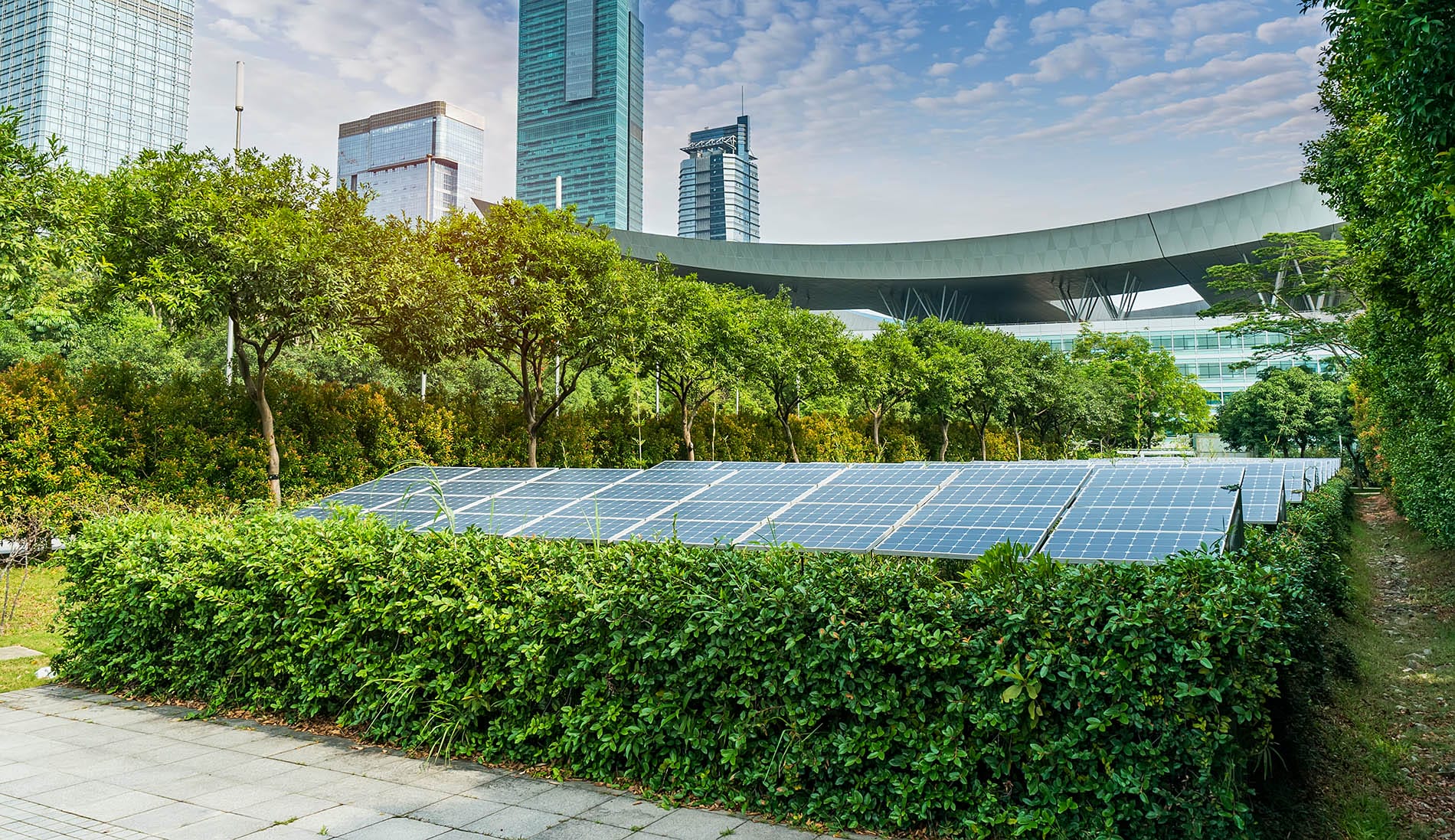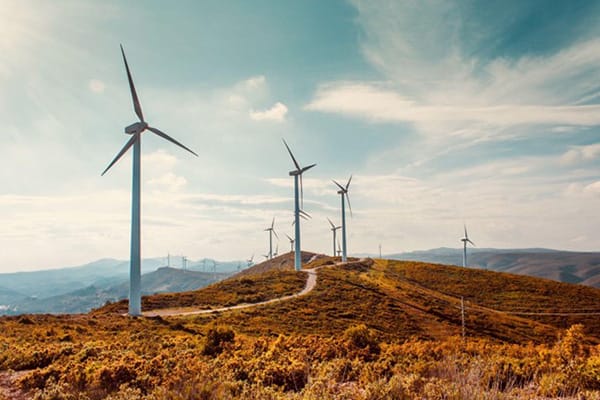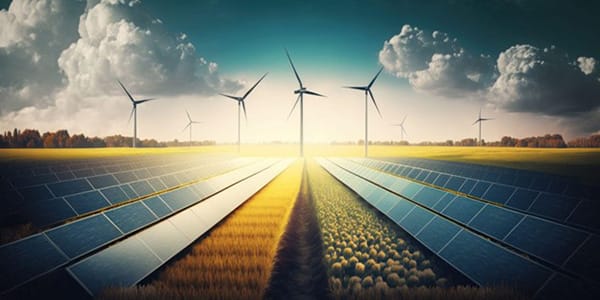By now, it has become common knowledge that reducing greenhouse gas emissions and lowering atmospheric carbon dioxide is an important part of combating climate change.
Renewable energies are energy sources, like wind and solar, that are self-replenishing. Because their energy production produces no emissions, they are an important part of reducing risks from a changing climate. But many people still have questions around renewable energy technologies, i.e., what they are, what forms they take, and how they work.
Let’s examine renewable energies in more detail to get a better understanding of the role they’ll play in powering the future.
What Is Renewable Energy?
As its name implies, the term “renewable energy” refers to energy production that comes from renewable energy sources, like sunlight, wind, and water. These sources of energy replenish themselves naturally.
While there may be a finite amount of fossil fuels such as natural gas available for powering human civilization, we’re at no risk of running out of energy from the sun, the wind, or the Earth’s natural heat.
Until fairly recently, the renewable energy sector was a negligible part of the world’s total energy mix. In the United States, nearly all the power came from natural gas, coal, and other fossil fuels.
One reason for this is the fact that renewable energy tends to be “flow-limited.” This means that a given source of renewable power might be effectively unlimited, but it’s hard to capture more than a small fraction of it at any one time.
Solar power is a good example. The sun continuously bombards the Earth with an incredible amount of energy — 173,000 terawatts, which is 10,000 times more than is used by the entire planet. But a great deal of ingenuity is required to gather it with solar panels, store it, and put it to work.
Renewable technologies have steadily been improving throughout the 20th century. Fears over unchecked climate change have created incentives to develop new technologies to overcome these challenges. As a result, renewable energy has become a larger and larger fraction of our energy mix. In 2021, 12% of total energy consumption in the United States was provided by renewables.
This is an important development. For one thing, there are clear benefits to human health that come from using clean energy. Breathing cleaner air, for example, results in:
- Fewer heart attacks
- Fewer asthma flare-ups
- Reduced injuries and deaths from heart and lung problems
But there are also major national security implications. Using more renewable energy will change the U.S.’s balance of energy imports and exports, contributing to greater energy security by reducing reliance on foreign sources of oil.
Why Is It Important to Use Renewable Energy Resources?
There are many reasons why it is important to use renewable resources. By pursuing a policy of decarbonization we can re-establish our economy on a sustainable footing, reducing the need for a painful energy transition later on. Renewable energy is also expected to boost energy efficiency and lower consumer prices for energy while simultaneously producing millions of new jobs.
What Are Examples of Renewable Energy?
There are several key examples of renewable energy industries. Together, they offer the hope of fostering an energy transition to renewable power while reducing air pollution from things like carbon emissions.
Common examples of renewable energy include the solar panels you might have installed on your roof, the gigantic white wind turbines you see dotting the landscape in states like Colorado, and the specialized facilities which produce energy from biomass waste.
Though the terms “renewable energy,” “clean energy,” and “green energy” are often used interchangeably, the Library of Congress considers them distinct concepts.
“Renewable energy” refers to energy production that comes from renewable sources, such as wind and solar. “Clean” or “green” energy, on the other hand, refer specifically to renewable energy that produces the absolute smallest impact on the environment.
Nuclear energy, for example, is renewable, but at present, it isn’t considered clean because it produces nuclear waste that must be stored and managed.
What Are the 5 Main Types of Renewable Energy?
There are five main ways of handling electricity production from renewable sources: solar, biofuels, wind, geothermal, and hydropower.
In the next few sections, we’ll cover each in turn.
Solar Energy
Also known as solar power, solar energy refers to any technology which allows us to harness the energy of the sun to do useful work. There are a few different ways of achieving this.
Solar thermal energy refers to the process of using the sun’s heat to turn a turbine, which then generates electricity.
A different approach is using photovoltaic cells in a solar panel to directly produce electric current. This grew out of pioneering work at Bell Labs in the 1950s, when researchers replaced older, less-efficient selenium photovoltaic cells with superior silicon photovoltaic cells.
The solar industry received a shot in the arm in the 1970s thanks to the oil embargo, when nations in the Organization of Petroleum Exporting Countries (OPEC) restricted oil production and oil exports to several countries, including the United States. With this critical fossil fuel harder to come by than ever, people in the affected countries began looking for promising alternatives, including solar power — the Solar Energy Research Institute was founded in Colorado just a few years later, in 1977.
Today, research into solar power continues thanks to investment from the private sector and government incentives. There is ongoing work to create utility-scale solar facilities (i.e., large solar plants able to produce at least one megawatt of power), as well as smaller residential systems (i.e., the solar panels people install on their roofs.)
Enter your ZIP Code and compare electricity rates
Biofuels
There are many forms of bioenergy, including biogas produced by sewage, municipal solid waste, and landfill waste, and biomass such as wood.
Burning wood may not seem like renewable energy, but trees regrow, so it counts. In fact, biomass was the main source of energy in the United States in the not-so-distant past. In the late 19th century, wood constituted as much as 70% of all energy used in the U.S.
Wood was supplanted as technologies were developed to better harvest and use alternative fossil fuels like coal and natural gas. This, combined with concerns over deforestation has meant that today wood is a fairly small fraction of the energy mix.
Still, it might be a larger amount than you realize; 12% of energy in the United States comes from renewable energy, and 17% of that renewable energy comes from wood, which means that around 2% of energy in the U.S. comes from wood.
If we zoom out to look at the more general picture, biomass — including wood, biofuels, and biomass waste — constitutes 40% of renewable energy.
“We’re not out of the woods yet,” as the saying goes!
Wind Energy
Wind energy has been harnessed for thousands of years in various forms, being put to work to perform labor-intensive tasks like grinding grain or pumping water. In 1887 it was used by Scottish physicist James Blyth to keep the lights in his cottage on, and the Jacobs brothers, Marcellus and Joseph, built the first commercial wind turbines in America in the 1920s.
In 2021, wind power accounted for more than a quarter of total renewable energy in the United States. Most of this comes from wind turbines, which spin a generator as the wind blows across their blades, producing electricity.
In most cases no one builds single wind turbines, they’re usually built in clusters called wind farms. There are two basic kinds of wind farms: onshore wind farms and offshore wind farms. As you can probably guess, onshore wind farms are located on land. They’re what you see when you drive through states such as California and Oregon.
Offshore wind farms, by contrast, are located in the water and are able to utilize the high winds that blow across the ocean, like the Block Island Wind Farm off the coast of Rhode Island.
Geothermal Energy
Geothermal energy utilizes geothermal heat from sources of hot water within the Earth. If this hot water makes it all the way to the surface, it can be utilized directly — you can relax in hot springs, for example.
A variant of this approach is the geothermal heat pump. Ground temperatures are relatively consistent just a few feet below the surface, so it’s possible to cool a building during the summer and heat it up during the winter by pumping fluid through buried pipes.
More generally, geothermal power plants will pump hot water up in order to spin a turbine, which generates electricity that can be put to use — dry steam, flash steam, and binary steam systems all work according to this basic design.
The generation capacity of geothermal technologies is increasing all the time. In 2021, seven U.S. states had geothermal power plants, producing a cumulative 16 billion kWh. California and Nevada led the pack, making up 70% and 24% of the total geothermal electricity generated in the United States, respectively. In Nevada’s case, geothermal energy made up nearly 10% of all the electricity generated within its borders.
Hydroelectric Power
Hydropower, or hydro for short, refers to any form of electricity generation which comes from the movement of water. As is usually the case, the most common way to do this is by moving water through a system to spin a turbine, which generates electricity.
Though this use of water goes back centuries to early water wheels, modern hydroelectric power plants are huge, sophisticated engineering projects capable of generating vast amounts of energy.
About 7% of the energy produced in the U.S. comes from hydro. The most typical forms are dams (think: the Hoover Dam). There’s also pumped storage hydropower, which involves filling a reservoir when electricity demand is low and letting it flow out when demand spikes.
How Much of the U.S.’s Energy Mix Comes From Renewable Energy Today?
As it stands today, most energy used in the U.S. still comes from fossil fuels. But thanks to investment from the private and public sectors, incentives from government programs like the Green New Deal, and a growing desire for alternative fuels, renewable energies are making up a larger and larger fraction of the energy mix.
According to figures from 2021, about 12% of total energy consumption in the U.S. came from renewables:
- Biomass (5%)
- Hydropower (2.3%)
- Wind (3.4%)
- Solar (1.5%)
- Geothermal (0.2%)
All told, these efforts mean that renewables are the U.S.’s fastest-growing energy source, increasing 42% in the decade between 2010 and 2020.
How Are Renewable and Non-Renewable Sources of Energy Different?
Renewable energy sources are ones that either replenish themselves naturally (i.e., wood from trees or heat from the Earth) or ones that are, for all intents and purposes, unlimited (like the sun). Non-renewable energy sources are limited in supply and will run out someday, like oil, and they also create pollution in the form of greenhouse gas emissions.
Renewable energy systems are crucial to the transition to sustainable energy. This transition is desirable because basing the U.S.’s energy use on renewable energy technologies can power us into the future indefinitely.
Renewed Interest in Renewable Energy
Shifting our energy production to cleaner, greener sources will require substantial investments in renewable energy sources like geothermal, solar, wind, and hydropower. But these power sources have a lot to recommend them. Because they are self-replenishing, we don’t have to worry about them running out, and they can lead to lower prices, more jobs, and a healthier population. To learn more about the advantages of renewable energy and all that it makes possible, check out our blog.
Brought to you by energysavings.com
All images licensed from Adobe Stock.
Featured image:




